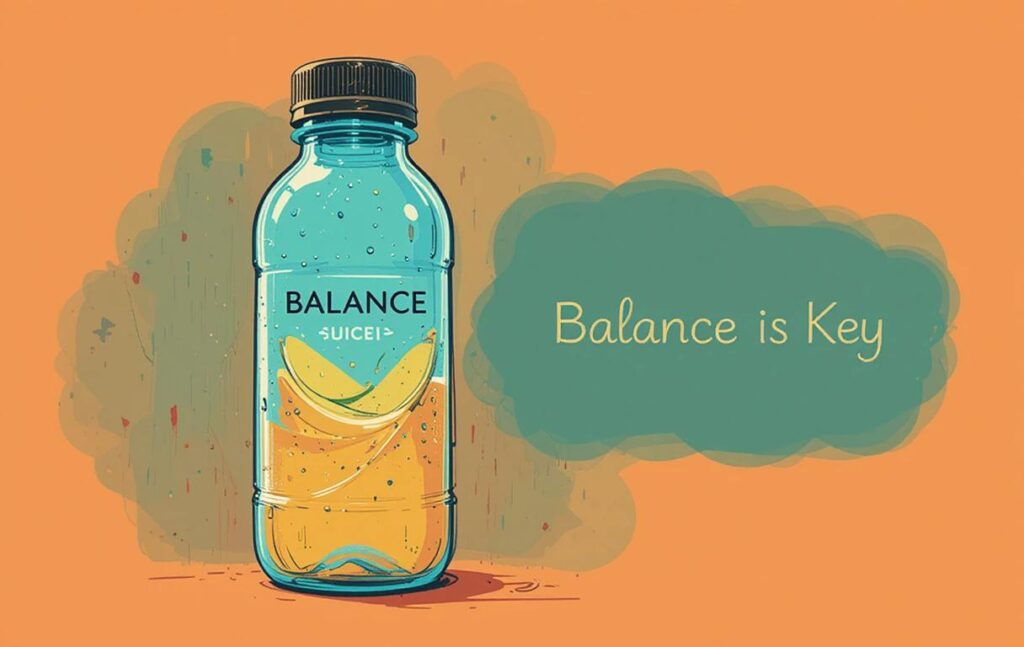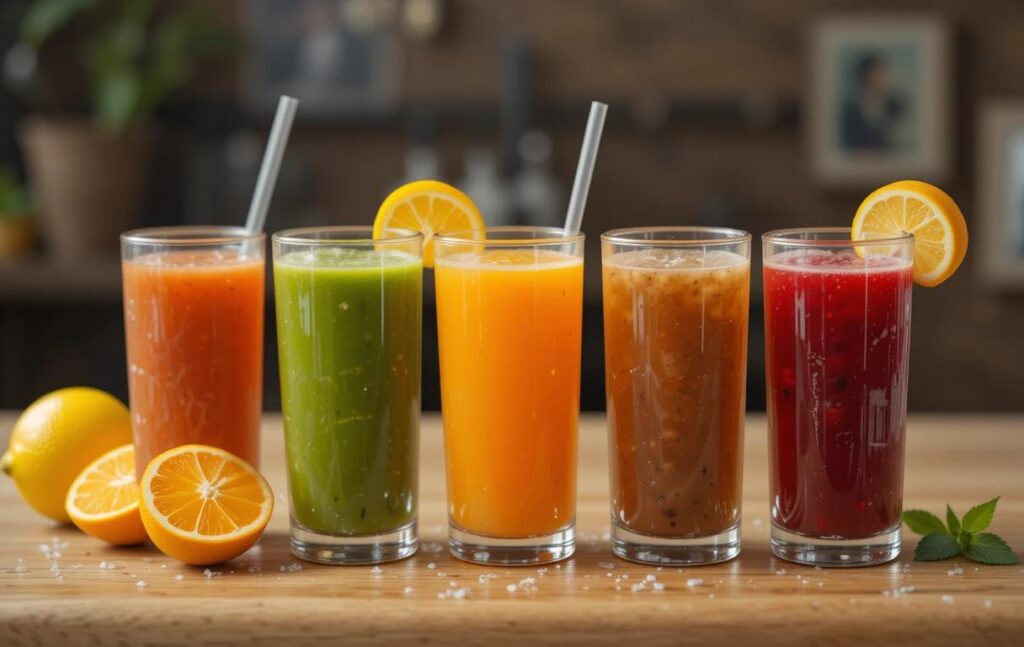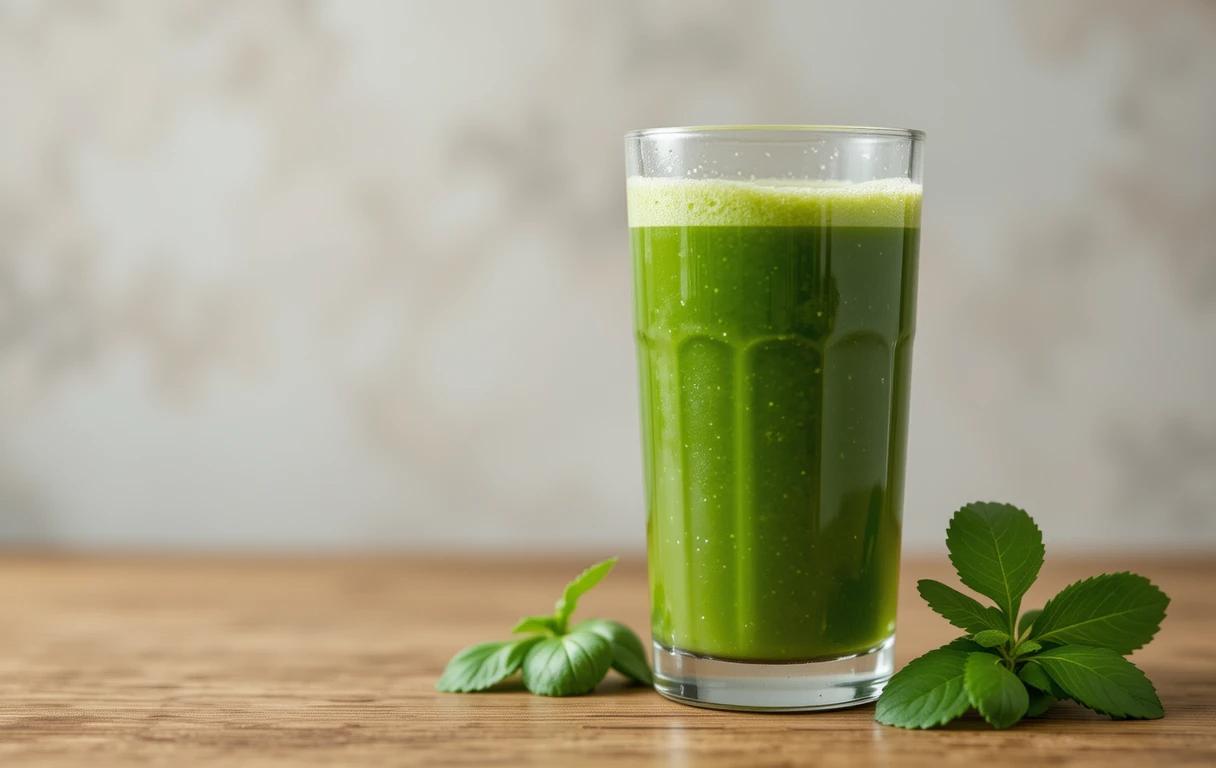How Much Weight Can I Lose in a Month Juicing?
Juicing has become a popular trend in the health and wellness industry, especially among those looking for a quick and effective way to shed extra pounds. If you’ve ever wondered, how much weight can I lose in a month juicing, you’re not alone. This article dives deep into the benefits, risks, and realistic expectations of juicing for weight loss, offering practical tips to maximize your success while ensuring a balanced approach to health.
Outline Recap
Here’s the structure of what’s to come in this comprehensive guide:
- What Is Juicing?
- How Does Juicing Work for Weight Loss?
- Benefits of Juicing for Weight Loss
- Potential Drawbacks of Juicing
- How Much Weight Can You Lose in a Month?
- Tips for Safe and Effective Juicing
- Sample Juicing Plan for Weight Loss
- FAQs About Juicing for Weight Loss
- Conclusion: Is Juicing Right for You?
What Is Juicing?
Juicing refers to the process of extracting liquid from fresh fruits and vegetables, creating nutrient-packed drinks that are easy to consume. Unlike smoothies, juicing removes most of the fiber from the produce, leaving a concentrated beverage rich in vitamins, minerals, and natural sugars. Many people turn to juicing as part of a detox or cleanse to improve digestion, boost energy, and kickstart their weight loss journey.
Why is juicing so popular?
The simplicity of juicing and the promise of quick results make it appealing. With just a juicer, some fresh produce, and a little creativity, you can create delicious drinks that nourish your body while supporting your weight loss goals.
How Does Juicing Work for Weight Loss?
Juicing can help you lose weight primarily through the following mechanisms:
- Calorie Deficit: Fresh juices are typically lower in calories than full meals, helping you reduce overall calorie intake.
- Nutrient-Dense Options: Juices pack essential vitamins and minerals that can support metabolism and overall health.
- Hydration Boost: Staying hydrated is crucial for fat metabolism, and juicing can significantly contribute to your daily water intake.
However, while juicing promotes weight loss, it’s essential to understand that not all juices are created equal. Store-bought juices often contain added sugars, which can counteract your efforts. Opting for homemade, fresh juices ensures you control what goes into your drink.
Benefits of Juicing for Weight Loss
Juicing offers several benefits that can make it an effective tool for weight loss. However, its success largely depends on how you incorporate it into your lifestyle and whether you use it as a supplement or a meal replacement. Here are the key benefits of juicing for shedding pounds:
1. Promotes a Calorie Deficit
Weight loss fundamentally boils down to consuming fewer calories than your body burns. Fresh juices, particularly those made with low-calorie vegetables like cucumbers, spinach, and celery, are an excellent way to achieve this. For example, a green juice made with leafy greens, lemon, and ginger can be as low as 100 calories per serving, far fewer than the average meal.
Example Recipe for a Low-Calorie Juice:
- 1 cucumber
- 2 cups spinach
- 1/2 lemon
- 1-inch ginger
This simple juice is refreshing, hydrating, and satisfying, helping you maintain a calorie deficit without feeling deprived.
2. Packed with Nutrients
Juices are nutrient powerhouses. They provide essential vitamins like Vitamin C, potassium, and antioxidants, which support overall health and metabolism. For instance, carrot and orange juice delivers beta-carotene and vitamin C, boosting your immune system while energizing your body for workouts.
Pro Tip: Pair juicing with a multivitamin or occasional solid meals to ensure you’re meeting all your nutritional needs.
3. Detoxifies the Body
Juices, especially those made from greens like kale and parsley, are often touted for their detoxifying effects. These ingredients help cleanse your system by supporting liver function, which is essential for metabolizing fat effectively.
Example Detox Juice Ingredients:
- Kale
- Parsley
- Apple
- Lemon
Drinking this kind of juice in the morning can kickstart your metabolism and improve digestion throughout the day.
4. Supports Digestive Health
Juicing gives your digestive system a break by providing easily absorbed nutrients without the bulk of fiber. This can be particularly helpful if you experience bloating or indigestion from heavy meals. The high water content in fresh juices also supports healthy bowel movements, keeping your gut in optimal condition.
5. Keeps You Hydrated
Hydration is often overlooked in weight loss plans. Drinking juices contributes to your daily water intake, helping your body stay hydrated and your metabolism run smoothly. Adding fruits like watermelon or cucumber to your juices increases the hydrating benefits.
6. Convenient and Time-Saving
In a fast-paced lifestyle, preparing balanced meals three times a day can be a challenge. Juices are quick to prepare and can replace meals or snacks when you’re short on time. Their portability also makes them perfect for on-the-go nutrition.
Pro Tip: Prepare your juices in advance and store them in airtight glass bottles to retain freshness for up to 48 hours.
Common Juicing Myths
While the benefits are compelling, it’s important to address common misconceptions. Many believe that juicing alone can provide all necessary nutrients. However, because juicing removes fiber, it’s not a complete dietary solution.
Solution: Complement your juicing routine with whole foods and occasional protein-rich snacks to keep your diet balanced.
Potential Drawbacks of Juicing

While juicing offers numerous benefits, it’s not without its challenges. Understanding the potential drawbacks ensures you can make an informed decision and avoid common pitfalls. Below are some of the key issues associated with juicing for weight loss:
1. Lack of Fiber
One of the primary downsides of juicing is the removal of fiber. Fiber is essential for digestion, stabilizing blood sugar levels, and keeping you feeling full. Without it, you may experience hunger sooner after consuming a juice, which could lead to overeating later in the day.
How to Address It:
- Pair your juice with a fiber-rich snack like a handful of nuts or a small serving of oats.
- Alternatively, consider blending instead of juicing to retain the fiber from fruits and vegetables.
2. Possible Nutritional Imbalance
Juicing focuses heavily on fruits and vegetables, which are great for vitamins and minerals but may lack other essential nutrients like protein and healthy fats. A diet primarily based on juices could lead to deficiencies, especially if followed for extended periods.
Solution:
Incorporate juices into a balanced diet rather than relying on them exclusively. For example, enjoy a green juice alongside a meal with lean protein, whole grains, and healthy fats.
3. High Sugar Content in Certain Juices
Fruits like oranges, pineapples, and mangos are naturally high in sugar. While these sugars are natural, consuming them in large quantities without the fiber to slow digestion can cause blood sugar spikes, potentially leading to cravings or energy crashes.
Pro Tip: Focus on vegetable-based juices and use fruits sparingly to add sweetness. For instance, mix cucumber, celery, and spinach with a small slice of apple or a handful of berries for natural flavor without excess sugar.
4. Potential for Muscle Loss
When juicing is used as a meal replacement for extended periods, your body may not get enough protein to sustain muscle mass. Losing muscle can slow your metabolism, making it harder to maintain long-term weight loss.
Solution:
Supplement your juicing routine with protein-rich snacks or smoothies that include plant-based proteins like chia seeds, hemp protein, or Greek yogurt.
5. Hunger and Cravings
Juices, being low in calories and devoid of solid content, might not satisfy hunger for long. This can lead to cravings or feelings of deprivation, especially if you’re used to larger, more filling meals.
How to Manage:
- Drink plenty of water between juices to stay hydrated and curb hunger.
- Include a small snack like raw vegetables, nuts, or boiled eggs between juice meals to stave off cravings.
6. Expensive and Time-Consuming
Quality juicing requires fresh, organic produce and a reliable juicer, which can quickly add up in cost. Additionally, preparing fresh juices daily can be time-intensive.
Tips to Save Time and Money:
- Buy produce in bulk and prep ingredients in advance.
- Invest in a juicer that’s easy to clean to make the process more efficient.
- Freeze pre-cut fruits and veggies in portioned bags to save prep time.
7. Temporary Weight Loss
While juicing can lead to rapid weight loss, much of the initial drop in weight may come from water loss rather than fat. Once you return to a regular diet, you may regain some of the lost weight if you haven’t built sustainable habits.
How to Avoid This:
Use juicing as a short-term tool to kickstart your weight loss journey but transition into a balanced eating plan for lasting results.
Balancing the Risks and Benefits
Juicing is most effective when used in moderation and complemented by other healthy lifestyle choices. Rather than relying solely on juices, think of them as an addition to a nutrient-rich diet.

How Much Weight Can You Lose in a Month?
Juicing has a reputation for producing rapid weight loss, but the actual results depend on several factors. Let’s break down what you can realistically expect and the variables that influence your progress.
1. Average Weight Loss on a Juicing Plan
For many, juicing can lead to an average weight loss of 8 to 10 pounds in one month. This result is highly individualized and depends on factors like the number of calories consumed, your activity level, and your starting weight. Some individuals have reported losing up to 15 pounds when combining juicing with exercise and healthy eating.
Why does juicing often yield quick results?
- Reduced Caloric Intake: Drinking juices instead of full meals naturally creates a calorie deficit.
- Elimination of Processed Foods: By focusing on fresh, whole ingredients, you avoid calorie-dense processed foods that can hinder weight loss.
- Water Loss: Initial weight loss often comes from water as your body detoxifies and sheds retained fluids.
2. Factors That Influence Weight Loss Through Juicing
a. Starting Weight and Health Conditions
Your starting weight plays a significant role. Heavier individuals may experience quicker drops in the first few weeks, while those closer to their ideal weight may see slower progress. Health conditions like hypothyroidism or insulin resistance can also impact your results.
b. Activity Level
While juicing, adding even light exercise like walking or yoga can amplify your calorie burn and boost weight loss. For more dramatic results, combining juicing with strength training or high-intensity interval training (HIIT) can accelerate fat loss.
c. Juice Composition
The ingredients in your juices matter. A juice made from predominantly high-sugar fruits like pineapple or mango can slow your progress compared to a juice focused on low-calorie vegetables such as spinach, cucumber, and celery.
Example Comparison:
- High-Sugar Juice: Orange + Pineapple + Mango (~200 calories, ~30g sugar)
- Low-Calorie Juice: Spinach + Cucumber + Lemon + Ginger (~70 calories, ~5g sugar)
d. Frequency and Portion Size
How often you juice and the quantity you consume also impact weight loss. Drinking large servings multiple times a day without monitoring calorie intake may counteract your efforts.
3. Realistic Expectations: Short-Term vs. Long-Term Results
Short-Term Results:
Juicing is excellent for quick results, especially if you’re looking to kickstart your weight loss journey. However, most of the initial weight loss during the first week is water weight rather than fat.
Long-Term Sustainability:
Sustained fat loss requires combining juicing with other healthy habits, such as balanced eating and regular exercise. A juicing-only diet is not recommended for long-term use due to its lack of essential macronutrients like protein and fats.
4. Testimonials and Real-Life Results
Case Study 1: Jessica, 32
- Plan: 3-day juice cleanse followed by juicing for one meal daily.
- Result: Lost 12 pounds in a month while incorporating daily walks.
Case Study 2: David, 40
- Plan: Juice fast for 14 days with low-intensity exercise.
- Result: Lost 10 pounds but reported hunger and low energy by week 2.
5. Measuring Success Beyond the Scale
Weight isn’t the only metric to gauge your success. Juicing can also improve:
- Energy Levels: Many people report feeling lighter and more energized.
- Skin Health: Antioxidant-rich juices can enhance your complexion.
- Digestion: The hydration and natural enzymes from fruits and vegetables can improve gut health.
The Verdict: Is Juicing Worth It for Weight Loss?
Yes, juicing can help you lose a noticeable amount of weight in a month, but it’s essential to set realistic goals and understand its limitations. It’s best used as a short-term strategy within a broader, sustainable weight loss plan.
Tips for Safe and Effective Juicing
To maximize the benefits of juicing while minimizing risks, it’s important to follow best practices. These tips ensure you achieve your weight loss goals safely and sustainably.
1. Prioritize Fresh and Whole Ingredients
The quality of your ingredients makes a significant difference. Always opt for fresh, organic produce to ensure your juices are free from harmful pesticides and packed with nutrients. Avoid using processed or canned fruits, which often contain added sugars and preservatives.
Pro Tip: Buy seasonal fruits and vegetables for maximum flavor and cost savings.
2. Balance Fruits and Vegetables
Fruits are naturally sweet, making juices more palatable, but relying too heavily on them can lead to high sugar intake. Aim for an 80/20 ratio of vegetables to fruits in your juices.
- Best Vegetables for Juicing: Spinach, kale, cucumber, celery, beets, and carrots.
- Best Fruits for Juicing: Green apples, berries, lemons, and limes.
Example Balanced Juice Recipe:
- 2 cups spinach
- 1 cucumber
- 1/2 green apple
- 1/2 lemon
- 1-inch ginger
3. Use Juicing as a Supplement, Not a Replacement
Juicing should complement your meals rather than replace them entirely. While a short-term juice cleanse can be beneficial, long-term meal replacement can lead to nutritional deficiencies. Incorporate juices as snacks, breakfast options, or accompaniments to solid meals.
Sample Day Plan:
- Breakfast: Green juice + a boiled egg.
- Lunch: Salad with lean protein.
- Snack: Beet and carrot juice.
- Dinner: Grilled chicken with steamed vegetables.
4. Include Protein to Prevent Muscle Loss
Protein is crucial for maintaining muscle mass during weight loss. While juices are rich in vitamins and minerals, they lack protein. Pair your juices with protein-rich foods like:
- Greek yogurt
- Chia seeds or flaxseeds
- Hard-boiled eggs
- Protein smoothies
5. Stay Hydrated
Juicing contributes to hydration, but it’s still important to drink plain water throughout the day. Staying hydrated helps with digestion, curbs hunger, and supports fat metabolism.
Goal: Drink at least 8 cups of water daily in addition to your juices.
6. Limit High-Sugar Fruits
Overloading your juices with high-sugar fruits like bananas, mangoes, and grapes can cause blood sugar spikes, leading to cravings and energy crashes. Stick to low-sugar options like:
- Berries
- Citrus fruits (lemon, lime, grapefruit)
- Apples
7. Prepare and Store Juices Properly
Freshly made juices are best consumed immediately to preserve nutrients. If you must store them:
- Use airtight glass containers.
- Refrigerate for up to 48 hours.
- Add a squeeze of lemon to delay oxidation.
8. Avoid Over-Juicing
Over-consuming juices can lead to excess calorie intake, even with healthy ingredients. Stick to 2-3 servings per day, each around 8-12 ounces, to prevent overloading on sugars and calories.
9. Listen to Your Body
Pay attention to how your body reacts to juicing. If you experience fatigue, dizziness, or intense hunger, it may be a sign to adjust your plan. Incorporate more solid foods or reduce the number of juice-only meals.
10. Add Superfoods for Extra Benefits
Boost your juice’s nutritional value by adding superfoods:
- Chia seeds: Rich in omega-3s and fiber.
- Turmeric: Reduces inflammation.
- Spirulina: A great source of plant-based protein.
Example Superfood Juice Recipe:
- 2 carrots
- 1 orange
- 1-inch turmeric
- 1/2 teaspoon spirulina
Safety Tips for Juicing
- Consult a Doctor: If you have a medical condition like diabetes or kidney disease, speak to a healthcare professional before starting a juicing regimen.
- Avoid Extended Juice Fasts: Prolonged juice-only diets can lead to fatigue, muscle loss, and nutrient deficiencies.
- Introduce Juicing Gradually: Start with one juice a day and gradually increase your intake to avoid overwhelming your system.
Sample Juicing Plan for Weight Loss

Having a structured plan can help you stay consistent and maximize your juicing results. Below is a sample 7-day juicing plan that balances nutrient intake, minimizes hunger, and supports sustainable weight loss.
Day 1: Detox Kickstart
Breakfast:
- Green Detox Juice:
- 2 cups spinach
- 1 cucumber
- 1/2 green apple
- 1-inch ginger
- 1/2 lemon
- Pair with a boiled egg for added protein.
Lunch:
- Carrot-Orange Energy Juice:
- 3 carrots
- 1 orange
- 1/2 teaspoon turmeric
- 1/2 lemon
Snack:
- Celery-Cucumber Cooler:
- 3 celery stalks
- 1 cucumber
- 1/4 lime
Dinner:
- Light Salad with leafy greens, grilled chicken, and balsamic vinaigrette.
Day 2: Hydration and Balance
Breakfast:
- Morning Glow Juice:
- 1 orange
- 2 carrots
- 1-inch ginger
Lunch:
- Metabolism Booster Juice:
- 2 cups kale
- 1 cucumber
- 1/2 lemon
- 1/2 green apple
- Dash of cayenne pepper
Snack:
- Watermelon Refresher:
- 2 cups watermelon
- 1/4 lime
Dinner:
- Baked salmon with asparagus and quinoa.
Day 3: Fiber and Flavor
Breakfast:
- Berry Green Juice:
- 1/2 cup blueberries
- 2 cups spinach
- 1/2 banana
- 1/2 lemon
Lunch:
- Immune-Boosting Juice:
- 2 carrots
- 1 orange
- 1-inch ginger
- 1/2 teaspoon spirulina
Snack:
- Apple-Beet Energizer:
- 1 beet
- 1/2 green apple
- 1/2 lemon
Dinner:
- Stir-fried tofu with broccoli and brown rice.
Day 4: Midweek Reset
Breakfast:
- Tropical Green Juice:
- 1/2 cup pineapple
- 2 cups spinach
- 1/4 lime
- 1 cucumber
Lunch:
- Refreshing Red Juice:
- 1 beet
- 2 carrots
- 1 orange
- 1-inch ginger
Snack:
- Lemon-Celery Splash:
- 3 celery stalks
- 1/2 lemon
- 1 cucumber
Dinner:
- Grilled chicken salad with avocado and olive oil.
Day 5: Boost and Burn
Breakfast:
- Fat-Burning Juice:
- 2 cups kale
- 1 cucumber
- 1/2 grapefruit
- Dash of cayenne pepper
Lunch:
- Vibrant Veggie Juice:
- 3 carrots
- 1 beet
- 1/2 lemon
Snack:
- Green Hydration Juice:
- 1 cucumber
- 1/4 lime
- 1/2 green apple
Dinner:
- Turkey burger with steamed green beans.
Day 6: Light and Refreshing
Breakfast:
- Citrus Sunrise Juice:
- 1 orange
- 1/2 grapefruit
- 1/2 lemon
Lunch:
- Zesty Carrot-Apple Juice:
- 2 carrots
- 1 green apple
- 1-inch ginger
Snack:
- Spinach-Lemon Pick-Me-Up:
- 2 cups spinach
- 1/2 lemon
- 1 cucumber
Dinner:
- Lentil soup with whole-grain bread.
Day 7: Final Detox Day
Breakfast:
- Final Cleanse Juice:
- 2 cups kale
- 1 cucumber
- 1/2 green apple
- 1-inch ginger
Lunch:
- Sweet Beet Detox:
- 1 beet
- 2 carrots
- 1/2 lime
Snack:
- Cucumber-Watermelon Refresher:
- 1 cucumber
- 1 cup watermelon
Dinner:
- Grilled shrimp with a side of roasted vegetables.
Bonus: Recipes for Weight Loss Juices
1. Green Detox Juice
- 2 cups kale
- 1 cucumber
- 1/2 green apple
- 1/2 lemon
- 1-inch ginger
2. Carrot-Ginger Energizer
- 4 carrots
- 1-inch ginger
- 1/2 lemon
Instructions: Juice ingredients, stir, and enjoy chilled.
3. Metabolism-Boosting Cayenne Juice
- 2 cups spinach
- 1 cucumber
- 1/2 grapefruit
- Dash of cayenne pepper
Instructions: Juice ingredients, stir in cayenne, and drink fresh.
Staying Motivated
- Keep a journal to track your progress.
- Pair your juicing plan with light exercise.
- Involve friends or family for extra accountability.
Frequently Asked Questions About Juicing for Weight Loss
Juicing is a popular weight-loss method, but it often comes with many questions. Below are the most frequently asked questions, along with clear and actionable answers.
1. Is Juicing Safe for Everyone?
Juicing is generally safe for most people when done in moderation, but it’s not suitable for everyone.
- Who should avoid juicing?
- Pregnant or breastfeeding women
- Individuals with diabetes (due to potential blood sugar spikes)
- People with kidney conditions (some ingredients, like spinach, can be high in oxalates)
Pro Tip: Always consult a healthcare provider before starting a juicing program, especially if you have pre-existing health conditions.
2. Can I Juice Instead of Eating Meals Permanently?
No, juicing should not replace meals long-term. While it’s nutrient-rich, juicing lacks essential macronutrients like protein and fats, which are crucial for overall health.
Recommendation:
- Use juices as meal supplements or replacements for short periods (1-7 days), followed by a balanced diet.
3. How Do I Avoid Losing Muscle While Juicing?
Since juices don’t provide enough protein, you risk losing muscle mass during prolonged juicing.
- Solution: Include protein-rich foods or supplements in your plan, such as:
- Whey or plant-based protein powders added to smoothies
- Snacks like boiled eggs or nuts alongside your juice
4. How Many Juices Should I Drink Per Day?
For weight loss, drinking 2-3 servings (8-12 ounces each) of juice per day is sufficient. Overconsumption can lead to excessive calorie or sugar intake, even from natural ingredients.
Sample Plan:
- Breakfast: Green juice
- Snack: Citrus or carrot juice
- Lunch: Vegetable-based juice
5. Will I Gain the Weight Back After Juicing?
Weight regain is possible if you return to unhealthy eating habits after a juicing plan. To maintain your results:
- Transition into a balanced diet with whole foods.
- Incorporate juices into your regular meals as snacks or beverages.
Pro Tip: Focus on long-term habits like portion control and regular exercise.
6. Are There Any Side Effects of Juicing?
Some people experience mild side effects when juicing, especially if they’re new to it. Common side effects include:
- Hunger: Due to the lack of fiber and protein.
- Fatigue: From low calorie intake during juice-only plans.
- Digestive Changes: Juices may cause diarrhea in some individuals.
Solution: Start slow, incorporate solid meals, and ensure juices are balanced with a variety of ingredients.
Conclusion: Is Juicing Right for You?
Juicing can be a powerful tool for short-term weight loss, helping you shed 8-10 pounds in a month if done correctly. It’s an excellent way to detoxify your body, improve hydration, and boost your nutrient intake. However, it works best when used as part of a balanced lifestyle rather than a standalone solution.
Key Takeaways:
- Use juicing to jumpstart your weight loss, not as a permanent diet.
- Prioritize vegetable-based juices to minimize sugar intake.
- Combine juicing with healthy eating and regular exercise for sustainable results.
- Listen to your body and consult a doctor if you experience adverse effects or have pre-existing conditions.
Remember, health is a journey, not a sprint. Incorporating juicing into your routine can help you take significant strides toward your goals while enjoying delicious, refreshing drinks.
Recipe: Healthy Green Juice
Related Recipes
- “Tuna Tomato Sauce Pasta Recipe“: A tomato-based recipe showcasing another way to use tomatoes.
- “Baked Chicken Fettuccine Alfredo with Broccoli“: Another comforting dish that can be complemented with tomato-based sauces.
Ingredient-Focused Content
- “Lions Mane Mushroom Recipe“: Suggest using a tomato gravy as a flavorful addition for plant-based dishes.
Cooking Techniques and Enhancements
- “Mango Habanero Salsa“: Explore complementary uses of sauces and gravies for flavor diversity.
Storage and Reuse Tips
- “Sous Vide Recipes“: Recommend tomato gravy as a sauce for sous vide-cooked meats or vegetables.
- “Ocean Spray Cranberry Sauce Recipe“: Guide readers on making and storing sauces, including tomato gravy.

